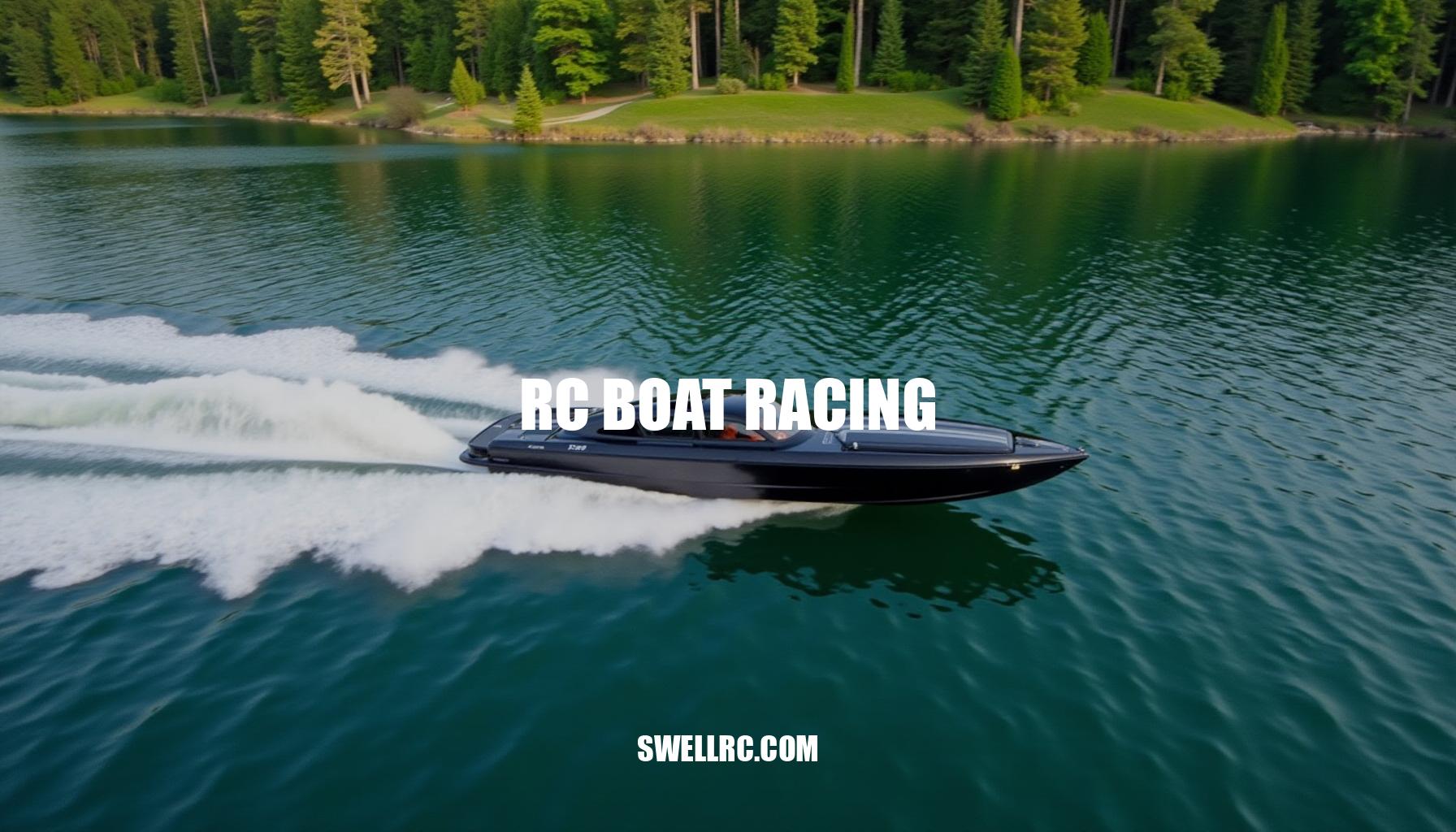Mastering RC Boat Racing: Tips, Tricks, and Techniques for Speed and Success
The first time my RC boat blew past 60 mph and carved a perfect arc through wind-chopped water, I felt the transmitter buzzing like a heartbeat in my palms—and I was hooked. RC boat racing is an exhilarating blend of speed, precision, and pure engineering joy. Whether you’re piloting hobby-grade RC toys on a quiet pond or competing in high-stakes radio-controlled racing events, this pastime challenges both your skill and technical know-how.
Understanding the nuances of remote control boats—from prop pitch adjustments to mastering hull trim—can make all the difference when milliseconds count on the track. In this guide, we’ll explore how to get started with model powerboats, select the right vessel to match your goals, and apply essential setup and tuning tricks that truly move the needle on race day. To help anchor your research, I’ll highlight proven platforms like the Blue Streak RC Boat (https://www.swellrc.com/blue-streak-rc-boat/) so you can choose your machine with confidence and dominate any club heat with precision driving.
Understanding RC Boat Racing: The Foundations of Speed and Control
RC boat racing spans several formats, each testing a different skillset. Oval racing runs counter-clockwise around buoys—clean lines and exit speed win heats. Offshore racing stretches over longer, rougher courses where endurance and stability matter as much as raw speed.
Straight-line events—drag and SAW (straightaway)—chase peak velocity and perfect setup.
Power classes typically divide into electric (brushless motors with LiPo batteries), nitro (glow engines), and gas (petrol 2-strokes). Electric is brutally fast and clean, nitro screams with high-rev power, and gas offers torque-rich, longer runtimes. Understanding electric vs.
gas RC boats or the debate between nitro vs gas vs electric RC can guide choices for racers depending on their priorities.
| Power Type | Speed | Cost | Maintenance |
|---|---|---|---|
| Electric | High | Moderate | Low |
| Nitro | High | Moderate-High | Moderate |
| Gas | Medium-High | Higher upfront | Sturdy cycles (Lower per-minute) |
Many RC racing clubs and associations (such as NAMBA, IMPBA, and NAVIGA) define competition rules, safety guidelines, hull classes, and technical specifications to ensure the fair and enjoyable racing of remote control boats. Exploring local listings or resources like rc sailboat racing near me is a great way to find meets nearby. Interestingly, many clubs host both powered and sailboat classes, and community interactions overlap more than you might expect.
The Machines Behind the Mayhem: Choosing the Right RC Boat
Understanding hull design and hydrodynamics is essential when selecting the perfect remote control boats for your racing needs. Each hull type offers unique advantages that dictate boat behavior on water:
| Hull Type | Characteristics | Best Use Case | Recommended Models |
|---|---|---|---|
| Deep-V Monohull | Slices through chop predictably, great for learning precise lines and stability. | Ideal for beginners and rough water conditions. | Best beginner RC racing boats fit this category well. |
| Catamaran | Rides on two sponsons for less wetted area, delivering blistering straight-line speed with confident cornering in moderate chop. | Perfect for high-speed circuit racing. | Traxxas M41 Snap-On Edition |
| Hydroplane (Outrigger) | Scalpel-fast in smooth water, skimming on tiny footprints but unforgiving in rough conditions. | Best suited for SAW-style speed runs on calm waters. | TFL Hobby RC Boats |
When it comes to power systems, brushless RC motors dominate the racing scene. It’s crucial to pick a motor kV rating that matches your propeller and battery cell count for optimal performance. Additionally, ensuring your ESC and motor are water-cooled enhances reliability and extends run time during intense racing sessions.
For those seeking serious power and customization, Bonzi Sports RC Boats offer robust gas setups that elevate performance significantly. Meanwhile, tuners who desire precision hardware and carbon fiber options often gravitate towards TFL Hobby RC Boats.
In summary, choose your model powerboats by aligning hull design with your skill level, budget, and local water conditions. Whether you prioritize stability, speed, or technical tuning, understanding the interplay of hull design and hydrodynamics along with the best brushless motor setups will ensure you pick a remote control boat suited to dominate the water.
Fine-Tuning for the Win: Setup, Upgrades, and Maintenance
Every tenth of a second in your RC boat setup tuning comes from disciplined processes honed over countless test days. Key elements include:
- Driveline: Align the motor-to-flex coupling precisely, ensure smooth rotation, and use blue threadlocker on set screws to prevent loosening.
- Center of Gravity: Position it about 27–33% forward of the transom initially, then adjust battery placement to eliminate porpoising or reduce plowing.
- Propellers: Prioritize sizing for temperature control first, then for speed. Balance, sharpen, and polish your props because an unbalanced propeller can steal top-end mph and damage bearings.
- Hardware: Fine-tune strut height and angle along with trim tabs to control lift, and adjust the rudder throw for both stability and crisp turn-in responses.
- Waterproofing: Seal the hatch with tape, grease the stuffing tube, apply heat-shrink tubing to exposed solder joints, and use dielectric grease on connectors to ensure robust waterproof electronics for RC boats.
- Electronics: Choose a properly rated ESC, maintain temperature control with water jackets and clean cooling lines.
Brushless RC motors offer better torque, efficiency, and longevity than brushed motors—select the right kV rating to match your LiPo voltage and propeller for optimal performance.
For hands-on examples of high-output tuning, consider the Max Power W-09 RC Boat, showcasing stout hardware and sensible prop selection unlocking speed without overheating components. If your plans include long offshore runs, the 45 Cigarette RC Boat style emphasizes cooling, runtime consistency, and predictable handling.
Maintenance is another critical pillar. After each run, flush the cooling system, rinse and dry all components, and relube the flex cable.
Every 5–10 runs, inspect bearings and couplers and deoxidize connectors. Seasonally, replace flex cables, recheck seals, and inspect hull seams. Track temperatures, GPS speed, and runtime carefully—turning raw data into informed adjustments for continual gains.
Following these tips for maintaining RC boats and focusing on precision in propeller tuning, waterproofing, brushless motor selection, and overall setup discipline will ensure your RC boat performs reliably and at peak speed.
Racing Day Essentials: Strategy, Community, and Skill Mastery
Race day embodies equal parts ritual and rhythm, making adherence to racing etiquette paramount. Start with a comprehensive pre-race checklist: verify battery IR and charge state, test range and failsafe, inspect prop edges, ensure cooling lines are clear, and confirm your mill-time plan. Strategy wise, keep lines smooth and eyes up; a tidy exit beats a dive-bombed entry every time.
Remember to respect buoy lines, call your lane clearly, and yield safely to dead boats, because good sportsmanship keeps everyone fast and safe. Engaging with RC racing clubs and associations is invaluable—ask the club’s quick drivers what adjustments they’d make for the day’s wind and chop, saving you weeks of trial and error.
Hauling gear and spares is half the battle; a dedicated RC truck with RC boat setup (https://www.swellrc.com/rc-truck-with-rc-boat/) can transform your pit area into a rolling command center, enhancing your transport and pit setup. To refine your skills further, embrace driving tips for RC boats by adopting a tester’s mindset: implement one change per run, note the results meticulously, and gradually build a personal playbook tailored for starts, traffic, and changing water conditions.
- Perform comprehensive pre-race equipment checks.
- Maintain smooth lines and situational awareness during the race.
- Respect course rules and practice good sportsmanship.
- Engage with the community through clubs and associations.
- Optimize your transport and pit setup for efficiency.
- Test changes methodically to improve performance over time.
Speed Records and Legends: Pushing the Limits of RC Boat Racing
Modern electrics have shattered ceilings—well-prepped SAW boats break 100 mph thanks to ultra-efficient hulls, razor-true props, and thermal headroom in ESCs and motors. It took me dozens of propeller balancing swaps to appreciate how a tenth of a millimeter in pitch or a subtle cup change can swing both top speed and water temps.
If you’re curious about what is the fastest RC racing boat, start with resources around the fastest RC speed boat. For big-water bravado, an RC offshore powerboat shows how longer hulls, stout drivetrains, and efficient cooling win when the course is rough and the laps are long.
The legends all share a theme:
- Meticulous balance in design and setup
- Ruthless reliability under punishing conditions
- Dedicated pilots who log more test laps than race heats
Exploring these high-performance RC boats reveals fascinating speed records continually pushed by innovation in propeller design, hull efficiency, and motor cooling. Whether you’re aiming for outright velocity or endurance on rough water, understanding the subtle interactions between components is key to mastering RC boating at its bleeding edge.
Conclusion – What I’ve Learned from Chasing Speed Across the Water
After fine-tuning more hulls than I can count, I’ve learned that winning in rc boat racing isn’t a matter of luck—it’s the compounding effect of clean builds, smart props, and consistent notes. This exhilarating sport blends precision engineering with heart-pounding adrenaline, making each race as much about technical skill as it is about passion.
Getting started with hobby-grade RC toys like the Blue Streak RC Boat you saw earlier gives you a solid platform to master the fundamentals. Success hinges on continuous performance tuning, where even the slightest tweak—whether it’s a tiny trim tab adjustment or smarter battery placement—can unlock your next breakthrough.
The power of the community racing scene can’t be overstated. Engaging with fellow enthusiasts accelerates your progress by sharing tips, builds, and strategies, making the journey as rewarding as the victories themselves.
- Focus on clean, efficient hull designs to reduce drag
- Experiment with propellers tailored for speed and torque
- Maintain detailed notes to track changes and outcomes
- Participate in community races to learn and improve
Stick with it—the future of RC boat racing is faster, tougher, and more accessible than ever, and there’s a spot on the driver’s stand with your name on it.
Frequently Asked Questions
- How do you start racing RC boats?
Join a local club, watch a few heats, and ask about beginner-friendly classes (often spec electric mono cats/monos). Start with a reliable brushless RTR or simple kit, learn course rules and mill starts, and practice consistent lines. Bring basic tools, spare props, and tape; keep notes on temps and setup changes. - What are the different types of RC boat racing?
Oval (buoyed circuits with counter-clockwise turns), offshore (longer, rough-water multi-lap courses), and straight-line events like drag and SAW (straightaway speed runs). Classes split by hull type (mono, cat, hydro) and power (electric, nitro, gas), with spec and open categories. - How fast can RC racing boats go?
Club spec electrics often run 25–40 mph, open FE race boats 60–80+ mph, nitro 60–90 mph, and gas 50–70 mph. Purpose-built SAW boats regularly exceed 100 mph in ideal, smooth-water conditions. - What’s the difference between brushed and brushless motors in RC boats?
Brushless motors are more efficient, more powerful per weight, and lower maintenance since there are no brushes to wear. Brushed systems are cheaper but run hotter and wear faster. Racing overwhelmingly uses brushless with water-cooled ESCs. - Are there international RC boat racing competitions?
Yes. NAVIGA hosts world-level championships; in North America, NAMBA and IMPBA run nationals and record trials. Many countries have regional leagues, and classes like FSR-V/O/H standardize competition across borders. - How do you waterproof electronics in an RC boat?
Seal the hatch with tape, grease the stuffing tube, use waterproof servos or boots, heat-shrink and conformal-coat exposed joints, and apply dielectric grease to plugs. Keep cooling lines clear and, after runs—especially in saltwater—rinse and dry the hull and hardware thoroughly. - Which hull design is best for speed and stability?
For ultimate top speed in smooth water, hydroplane outriggers dominate. For a balance of speed and cornering stability on typical club water, catamarans excel. In chop and offshore conditions, deep-V mono hulls provide the most predictable stability. - Can RC boats race in saltwater?
Yes, but rinse with fresh water immediately after each run, use stainless or coated hardware, protect electronics with corrosion inhibitors, and flush cooling lines. Expect slightly lower speeds due to denser water and be extra vigilant about corrosion.



